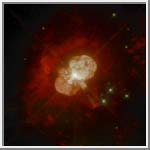|
COMETS EARTH JUPITER KUIPER BELT MARS MERCURY METEORITES NEPTUNE OORT CLOUD PLUTO SATURN SOLAR SYSTEM SPACE SUN URANUS VENUS ORDER PRINTS
PHOTO CATEGORIES SCIENCEVIEWS AMERICAN INDIAN AMPHIBIANS BIRDS BUGS FINE ART FOSSILS THE ISLANDS HISTORICAL PHOTOS MAMMALS OTHER PARKS PLANTS RELIGIOUS REPTILES SCIENCEVIEWS PRINTS
|
Related Document
Download Options
A NASA Hubble Space Telescope "natural color" image of the material surrounding the star Eta Carinae, as imaged by the Wide Field Planetary Camera 2 (WFPC-2). The Camera was installed in the Hubble Space Telescope during the STS-61 Hubble Servicing Mission. The WFPC-2 optically corrects for the aberration of the telescope's primary mirror, restoring the telescope's vision to its originally planned clarity. Eta Carinae has a mass of approximately 150 times that of the sun, and is about 4 million times brighter than our local star, making it one of the most massive and most luminous stars known. Eta Carinae is highly unstable, and prone to violent outbursts. The last of these occurred in 1841, when despite its distance (over 10,000 light years away) Eta Carinae briefly became the second brightest star in the sky. Pre-servicing mission HST observations taken with the WF/PC-I reveled new detail in the rapidly expanding shell of material which was ejected during the last century's outburst. However, the earlier effects of HST's spherical aberration obscured the structure of the material very near Eta Carinae itself. The clear view of Eta Carinae now provided by WFPC-2 dramatically demonstrates the ability of HST to reliable study faint structure near bright objects. The picture is a combination of three different images taken in red, green, and blue light. The ghostly red outer glow surrounding the star is composed of the very fastest moving of the material which was ejected during the last century's outburst. This material, much of which is moving more than two million miles per hour, is largely composed of nitrogen and other elements formed in the interior of the massive star, and subsequently ejected into interstellar space. The bright blue-white nebulosity closer in to the star also consists of ejected stellar material. Unlike the outer nebulosity, this material is very dusty and reflects starlight. The new data show that this structure consists of two lobes of material, one of which (lower left) is moving toward us and the other of which (upper right) is moving away. The knots of ejected material have sizes comparable to that of our solar system. Previous models of such bipolar flows predict a dense disk surrounding the star which funnels the ejected material out of the poles of the system. In Eta Carinae, however, high velocity material is spraying out in the same plane as the hypothetical disk, which is supposed to be channeling the flow. This is quite unexpected. The WFPC-2 observations of Eta Carinae raise as many questions as they answer. Image use statement at the time this image was obtained. All of the HST images available via WWW and ftp may be used without restriction as long as credit information accompanies the picture. Credit usually includes the principal scientist responsible for the data, AURA/STScI, NASA and/or ESA, the European Space Agency. Specific credit information may be found in the captions accompanying the images as plain text files. The captions are available via links from the Web pages as well as separate files in the gif directory on the ftp server. |
